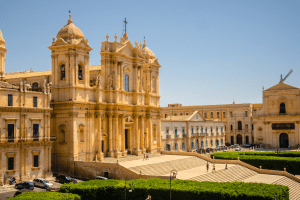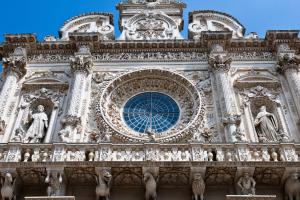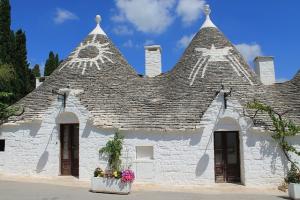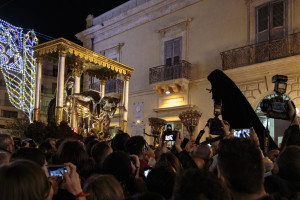- Blog
- City of Catania
City of Catania
The Territory - Catania is located on the island's east coast, at the foot of Mount Etna. It's a densely populated city, it has about 289 650 inhabitants, it’s the capital of the province and includes 58 municipalities.
Today, Catania is a modern and ancient city at the same time. It houses many monuments of extraordinary historical and architectural value, dating back to various periods and many conquerors. It's also equipped with modern facilities such as the International Airport and the Circumetnea. In addition, the city boasts a prestigious university, a modern industrial area, known as the Etna Valley, and a rich commercial center.
The grandeur of Mount Etna, the spectacular coastline full of equipped beaches, nature trails and the Reserves, the uniqueness of the architecture of its monuments, make the area of Catania one of the most precious pearls of the Val di Noto. In this regard, Catania has been recognized as UNESCO World Heritage in 2002, along with seven other late Baroque towns of the Val di Noto, Caltagirone, Militello Val di Catania, Modica, Noto, Palazzolo, Ragusa and Scicli.
The uniqueness of Baroque architecture, which featured the rebuilding of the city after the earthquake of 1693, favored their inclusion in the list of Italian cultural heritage unique in the world. With regard to food, the province of Catania offers an extraordinary variety of foods, as well as being part of the traveling circuit of the Roads of Wine.
The principal monuments - Catania still preserves testimonies related to the rulers of ancient times. Dates back to the Roman period the Roman Theatre (located in the historic center of the city, between Piazza San Francesco, Via Vittorio Emanuele, Via Timeo and Via Greek Theater); the Odeon (near the Roman Theatre); Amphitheatre (accessible from Piazza Stesichorus); the Baths of the Indirizzo (sited in Piazza Currò), the Termes della Rotonda (sited in Via della Rotonda), the Achilliane Baths (in Piazza Duomo, accessible from the Diocesan Museum of Catania).
For the purpose of enhancement of this great historical heritage and culture, was established the Greek-Roman Archaeological Park of Catania (located in Via Vittorio Emanuele II, 266). Date back to the Svevo time the portal of the Church of Sant'Agata al Carcere and the Ursino Castle. Funded by Frederick II in the thirteenth century, it’s situated in the square with its founder’s name and houses the Civico Museum. Testimony of the Aragonese period is the Palace Platamone, whose origins date back to the noble family of Platamone, one of the most prestigious and influential of the Kingdom of Sicily. Today the palace (sited behind Piazza Duomo), is home to the Department of Culture of the Municipality, and various exhibitions. Of the Renaissance period, is the Benedictine Monastery, located in Piazza Dante, that was joined to the Church of St. Nicholas Arena. The building of the structure dates back to 1558, the monks who lived in the monastery until 1866, came from the nobility and conferred the building a major role and cultural prestige. Today the monastery is head office of the Faculty of Humanities and Foreign Languages and Literatures.
The Fountain of the second Renaissance courtyard and colonnade of the cloister, represent the imposing remains of the former convent. The origins of the walls on which now stands Porta Garibaldi, also known as Port Ferdinand, (located between Piazza Palestro and Piazza Crucifix, at the end of Via G. Garibaldi) also date back to the Renaissance period . The area is called "u Futtinu" (fort), in memory of a curtain wall built by the Duke of Ligne, after the catastrophic volcanic eruption of 1669, which struck the city on the western side destroying all defenses walls. The most important monuments of Catania date back to the period of the Baroque reconstruction after the 1693 earthquake that leveled the south-eastern part of Sicily. Dating back to the Baroque period the Cathedral of St. Agatha; the Church of the Abbey of St. Agatha; the Church of St. Agatha la Vetere; the Church of Sant'Agata alla Fornace; the Church of San Placido (on the square); the Basilica of the Collegiate (directed Chapel Street in Etna); the Palace of the Elephants (town hall in Piazza Duomo); the Palace of Seminar of the Clerics and the Fountain dell'Amenano (Piazza del Duomo); Palazzo Biscari (Via Biscari); Palazzo del Toscano (in Stesichorus Square); Palace Reburdone (in Via Vittorio Emanuele II); Minoriti Palace (head office of the Province of Catania, located between the Cathedral Square and the Roman Amphitheatre); Villa Cerami (in Crociferi Street, home of the Faculty of Law); Uzeda Gate (Via St. Joseph Dusmet, gateway to the Piazza Duomo); the Elephants Fountain, said "u liotru" (located in the center of Piazza Duomo). The monument, made of lava stone, is topped by an Egyptian obelisk of granite, symbol of Catania. There are no reliable data on when and by whom the statue of the elephant was built. An ancient legend tells of an elephant that would have hunted wild animals during the foundation of the ancient Katane.
To remember in Catania: the famous Via Etna, the main street of the old town, a long carpet of lava stone of about 3 km; Villa Bellini, along the Via Etna, the public garden of the city, opened in 1883 and named after the famous composer born in Catania; the well-known "fera o luni", the famous market of Catania, Via S. Gaetano sited between the Grotta and Stesichorus Square, so named because it originally took place only on Mondays. Today, the fair is held every morning, and Sunday is transformed into a typical flea market.
Catania is known for its vibrant and ancient theatrical and musical tradition. With its 25 theaters, the city is presented to the fans and the curious with various types of entertainment: the puppet theater, the opera, the ballet, the Greek tragedies and experimental theater. The main theaters are the Teatro Massimo Bellini, and the Teatro Stabile. The Teatro Massimo Vincenzo Bellini, Via Perrotta, in the beautiful scenery of the historic center of the city, was inaugurated in 1890 with the masterpiece, “La Norma”, composed by Bellini. In the theater, which houses one thousand two hundred seats, are held every year a season of opera and symphonic and a season of chamber concerts. The Teatro Stabile di Catania is one of the main cultural centers of the city with three theaters: the major which is the Teatro Verga, Teatro Angelo Musco and the Ambassadors Theatre.
Catania is also the capital of culture. Of great importance is the Literary Park "Giovanni Verga", dedicated to the great writer and poet from Catania. The city is also home to several museums, Houses-Museum, Libraries. Among the main museums, to remember the Bellini Civic Museum; the Museo Emilio Greek.
One of the highlights of the year is the Festival of Sant'Agata, the saint patron of Catania. A religious festival that every year on the 3rd, 4th and 5th of February, combines tradition, folklore, gastronomy, enhancing the identity of a territory rich in extraordinary resources.
A bit of history - According to historical sources the city of Katana (the ancient Catania) was founded between 729 and 728 BC by a colony of Greeks coming from Chalcis. After the domination of Syracuse by the tyrant Hieron of Syracuse, the city was conquered by the Romans in 263 BC, becoming a "colony" and gaining importance and wealth. Catania also knew the period of the barbarian invasions in the second half of the fifth century, the Byzantine occupation until the Arab conquest in the ninth century. In 1060, Sicily was prey of the Normans of Altavilla, who came to occupy Catania in 1072. The Marriage of Constance d’Altavilla, daughter of Roger II, with Henry VI of swabian, son of Frederick Barbarossa, consecrated the power of the Swabians in Sicily. In 1266 Sicily was ruled by Charles of Anjou for a short period, until 1282, when it began the uprisings known as the "Sicilian Vespers" that put an end to the domination of the island by the French dynasty. At the beginning of the uprising, the Aragonese fleet led by Peter of Aragon, had already landed in Sicily. This favored the Aragonese domination in the island from 1282 to 1415. During the Aragonese, the city experienced a period of recovery and cultural ferment. During this period was built the first university on the island and Catania became the capital of the Kingdom of Sicily. The following Spanish domination and the devastating earthquake in 1693, brought the city to a severe economic crisis. However, in the years of "reconstruction" Catania became one of the most flourishing cities of the Italian trade. After taking part in the riots for independenceof in 1848-49 , Catania became part of the Kingdom of Italy in 1861. The nineteenth century saw the city grow from the point of view of cultural, literary, musical and theatrical. This development was maintained up to today, making Catania become one of the 15 metropolitan cities of Italy.






